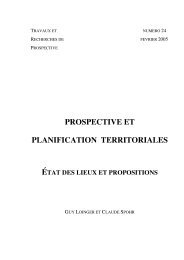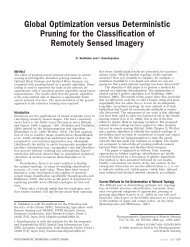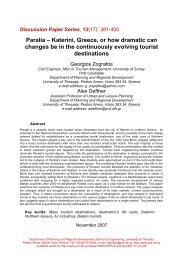International Journal of Architectural Research
International Journal of Architectural Research
International Journal of Architectural Research
Create successful ePaper yourself
Turn your PDF publications into a flip-book with our unique Google optimized e-Paper software.
<strong>International</strong> <strong>Journal</strong> <strong>of</strong> <strong>Architectural</strong> <strong>Research</strong>Pantoleon Skayannis• Proposals <strong>of</strong> private investors for certain parts <strong>of</strong> the city that frequently require changing<strong>of</strong> land uses coming in conflict with existing planning regulations. These are divided intothe ones that require point changes and to those that require greater interventions and aset <strong>of</strong> changes. In both cases such interventions have to come to terms with the fact <strong>of</strong>the necessity for the revision <strong>of</strong> the strategic city plan <strong>of</strong> Athens. Such plans have beencriticized that are leading to an uncontrolled gentrification process which will make lowersocial strata worse <strong>of</strong>f, while favouring those who have exploited the situation sometimesat the verge <strong>of</strong> legality.• Proposals (or objections to proposals) from various local, neighbourhood etc.communities <strong>of</strong> the city, and from political or municipal parties. These are normallyfocussing on partial issues <strong>of</strong> the related interested parties. In this sense they easily fallinto the trap <strong>of</strong> ‘city beautiful’ or naïve romanticism and fail to face the overall complexity<strong>of</strong> the city.• Proposals from the city planning department <strong>of</strong> the municipality <strong>of</strong> Athens ordered by themunicipal council, or the mayor, regarding special areas for which interventions aresought, or redesign is required. While such plans are more comprehensive (contrary toother plans), they face the problem that the municipality <strong>of</strong> Athens faces, i.e. lack <strong>of</strong> fullcompetence for their implementation, as this municipality has far less rights for the area <strong>of</strong>Athens than the government ministries.As becomes evident, the proposals for the city vary and several planners have raised theobjection that the proposals are partial and many are more <strong>of</strong> an urban design nature rather than<strong>of</strong> a planning one (esp. those <strong>of</strong> the ministry YPEKA !!!), at a time when the city needs deepstructural interventions. Undoubtedly, several <strong>of</strong> these proposals are worth serious consideration.They reflect genuine interest from several parties or entrepreneurial pursuits, but have an obviouscommon denominator: they are not comprehensive. Thus, except <strong>of</strong> a part <strong>of</strong> the RPA-2021, andeven more recently <strong>of</strong> an initiative <strong>of</strong> the mayor <strong>of</strong> Athens (Economou, Skayannis, Deffner, et al,2012) no new provisions for comprehensive planning have been made.In parallel, several <strong>of</strong> the plans are formally discussed (for approval, dismissal, or foramendments) at the district level under a procedure that is foreseen by the law. However, thequestion is how such plans are carried out with essential participation <strong>of</strong> the community theyconcern, and the general plans (for the entire city) with a considerable and meaningful publicdebate with all stakeholders concerned and individual citizens. In such a debate, the planners arenot supposed to have finalised their opinion and try to sell the plan but are expected to bereceptive <strong>of</strong> the valuable knowledge articulated in the consultations.Instead <strong>of</strong> this, public debate has acquired two faces: a) interested parties are invited toexpress their opinion about an intervention or a plan. Frequently, this becomes a formality. Thereis never enough time to study a proposal or a plan, and the interested parties <strong>of</strong>ten have noexpertise or the resources to deal with it (Skayannis and Kaparos, 2010). b) In other cases <strong>of</strong> amore localized nature, local communities do have and express an opinion, which up to a certainextend is taken into account. Most <strong>of</strong> the times these opinions concern local demands, andfrequently these demands are related to electioneering purposes and aims <strong>of</strong> local politicians(Skayannis and Kaparos, 2010). c) Frequently, special entrepreneurial interests are expressedand exercise pressures for measures and regulations, yet these are not harmoniously linking tothe more general approach <strong>of</strong> a plan.Yet in all cases planning is by and large top down. In this top-down context, plannersusually ask the opinions <strong>of</strong> stakeholders during the planning process and selectively utilize it, butin most cases one could reasonably argue that there is no substantial collaborative orparticipatory planning.Archnet-IJAR, Volume 7 - Issue 2 - July 2013 - (192-205) – Selected Papers202Copyright © 2013 Archnet-IJAR, <strong>International</strong> <strong>Journal</strong> <strong>of</strong> <strong>Architectural</strong> <strong>Research</strong>















